If only the second two-thirds of Shaun of the Dead (opening 9.24) were as good as the first third…
The geeks calling this thing a way cool horror-comedy are deluding themselves. The threat element is shit and the story tension goes south around the 35-minute mark. You can’t just say “it’s a spoof” and leave it at that because spoofs have rules. They’ve got to show the same levels of propulsion and credibility that the films they’re spoofing have, or the game falls apart.
I got into this briefly in a WIRED item, but the Shaun script (by director Edgar Wright and costar Simon Pegg) is about two London slacker-somethings in their late 20s having to contend with a sudden invasion of flesh-eating ghouls in their local neighborhood (and which is manifesting all over England, a la 28 Days Later.)
Shaun (Pegg) has fed-up-girlfriend issues and is resisting the growing-up process, and to call his fat layabout friend Ed (Nick Frost) emotionally retarded would be a form of understatement.
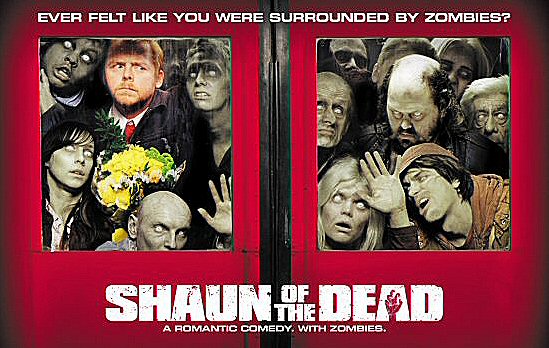
The funniest scene happens just as the ghoul plague has begun. Simon walks through the neighborhood on his usual run to the grocery store and doesn’t even notice what’s going on. Then he goes home, turns on the tube and surfs right past the horrific reports on the news channels.
The problem is that the zombies aren’t threatening enough. They walk and react way too slowly, so agile humans aren’t in any kind of serious peril and so the story tension suffers. The Shaun zombies are like the mummy in Abbott and Costello Meet the Mummy (’55). They rarely do anything that even a seven year-old would consider half-threatening.
The Shaun zombies catch and eat people on occasion, but they’re much slower and less ferocious than George Romero’s zombies in Night of the Living Dead or Dawn of the Dead.
And all you have to do is give them a hard blow to the head and they’re dead. What happened to having to penetrate the skull? The Shaun survivors use a repeat-action Winchester rifle to defend themselves at one point, but it seems silly to have only 32 shells at their disposal with 100 or more ghouls trying to get at them.
Shakedown
I’ve already mentioned how rich, flavorful and well-ordered Sideways is. It’s Alexander Payne’s best film since Election ; his most emotionally ripe and mature. It’s a candidate for Best Picture, Best Director…blah blah, I’ve said all this.
I’m getting the idea that Sideways‘ s Oscar chances are pretty fair, actually. Not just the film itself but Giamatti for Best Actor, Haden-Church for Best Supporting Actor and costar Virginia Madsen for Best Supporting Actress, et. al.
I obviously don’t know anything about films I haven’t seen, but I’m getting these queer premonitions about Oliver Stone’s Alexander and Martin Scorsese’s The Aviator. (Dan Fellman’s recent comment about Alexander (see WIRED) is the kind of thing I’m talking about. And I don’t trust Martin Scorsese with big budgets — he’s better when there’s less to paint with).

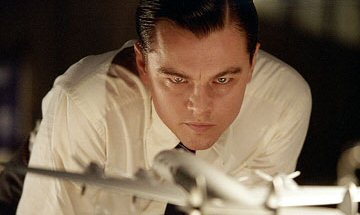

These films might be spectacular, pretty good’s or just so-so’s. It goes without saying there should be no assumptions about anything.
Taylor Hackford’s Ray is good but too long, I’ve read. Closer has been playing “a little cold,” I’ve heard, and we all know what that means when it comes to a certain brand of Academy voter. Others don’t seem to love and worship Collateral as much as me, but maybe I’m reading it wrong. And more and more people are telling me they were disappointed by The Motorcycle Diaries.
The Best Picture race may come down to Spanglish, The Motorcycle Diaries (an increasingly big maybe), Hotel Rwanda, Sideways and, depending how the election goes, Fahrenheit 9/11.
I was told last weekend that Sideways will probably take in $30 million, at best. But if word gets around in the right way, it’ll do better.
A good portion of Sideway‘s story is driven by adolescent behavior. This is catnip for under-25 crowds. My kids loved that scene in Election when Matthew Broderick throws the plastic container of Pepsi at the limousine (i.e., the one with Tracy Flick in it) and then runs when the limo driver hits the brakes. Payne gets adolescent guy-rage. He’s obviously tethered on some level.
There are three such scenes in Sideways, two of them gut-bustingly funny. They’re going to be word-of-mouth selling points when it opens. No descriptions. Just see it on 10.20.
Sipping Sideways
Fox Searchlight invited several press people up to Santa Barbara last weekend for a Sideways film junket. I accepted at the drop of a hat. I reside in a nice minimum-security prison with privileges (cable TV, music, food, evening screenings), and any time away from my work space is prime.
The deal included a suite at the Bacara hotel and spa in Goleta (about 12 minutes west of Santa Barbara, just past Isla Vista), a complimentary T1 line in the hotel room, too much food, a wine-tasting party, moonlight walks on the beach, all kinds of beautiful women everywhere, more food, and chats with Sideways writer-director Alexander Payne and costars Thomas Haden Church and Virginia Madsen.
I drove up late Saturday afternoon. About 90 minutes, give or take. I checked into the Bacara around 6 pm. Swanky, expensive, built four years ago. Spanish mission style. A series of two-story buildings sloping downhill and all of it landscaped to death. The cheapest rooms go for $400 a night. The vibe felt a bit too rich for my blood.
The drive back to Santa Barbara for the wine party felt longish. (If the Bacara were farther away it couldn’t be in Santa Barbara. It’s out there.) Publicists at the door told me I’d missed a 5 pm screening of Sideways, which nobody told me about. I’d like to catch it again soon.
Alexander Payne was there without his wife, Sideways costar Sandra Oh. I asked him why his usually longish hair was cut short. “You have to cut back the rose bush every fall,” he replied. I spoke briefly to Madsen. Paul Giamatti wasn’t there due to a family situation. I saw Church but didn’t approach.

Top to bottom: At the Bacara Hotel round tables : Sideways producer Michael London (l.) and director Alexander Payne; Thomas Haden Church (in blue shirt); Virginia Madsen; Payne again (below Church); my hotel room at the Bacara; view from the terrace
There wasn’t enough food but plenty of wine. Santa Barbara Film Festival director Roger Durling was there and friendly, as always. Marina Zenovich, who’s making a doc about Roman Polanski, was sitting at a table with producer Jasmine Kosovic (The Adventures of Sebastian Cole).
I would say a great majority of business cards you hand to people at these parties end up in the garbage can. I would say that a great majority of things people say to each other at these parties are insincere or flat-out false. But I like going to them anyway.
I wandered around the Bacara bar area when I got back. The hotel is nicely designed, but it gives off a strange feeling of segregation. I’ll bet the same vibe existed in the ruling-class-only Palatine section of Rome during the reign of Tiberius.
I’m going to run the interviews I recorded with Payne, Sideways producer Michael London, Church and Madsen in the VERBATIM section starting next week.
I’m a particular fan of Church’s performance as Jack, an actor friend of Paul Giamatti’s Miles who’s due to be married in a few days but is determined to get laid during their wine-country safari any which way he can. It’s one of those last-gasp, go-for-the-gusto-before-surrendering things. Jack is a small child, but Church gives him a kind of dignity because he takes hound-dogging very seriously.
You should have heard the journos at the table imparting their p.c. sentiments about what a despicable misogynist Jack is. Bullshit — he’s like 80% of all the engaged guys I’ve ever known or heard about. (And for what it’s worth, I’ve been lucky twice with women who were about to get married. I know that the main reason they waved me in was because they knew this was their last shot before reciting marriage vows.)
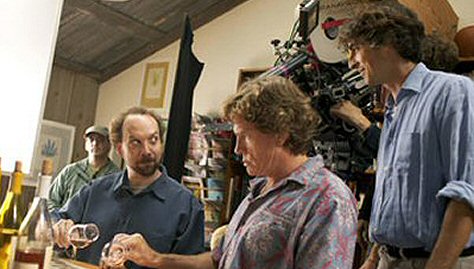
The Sideways shoot had been described by Payne as extremely pleasant. I asked Payne and London if there’s anything analogous between on-set alpha vibes and first-rate final cuts. I’m not saying everyone has to miserable during shooting in order for a film to turn out well, but creative endeavors of consequence are rarely a slap-happy thing. Distillation — compressing, honing — is not a day-at-the-beach activity.
There’s no fixed rule. Bad films have been made on happy sets and superb ones have come from sets in which everyone hated each other. I just know my guard always goes up when I hear how much fun it was to make this or that film. Nobody seemed to get what I was saying. They all said, “You don’t have to be miserable to make a good movie.” I didn’t say you had to be miserable. I said…forget it.
There was a journalist from About.com who brought up the issue of Virginia Madsen’s performance being a comeback, but he did so in a chickenshit way by remarking she’d never really been away. Madsen said thanks, smiled and corrected him. Her last big hit, she said, was 1992’s Candyman.
Madsen said her career has been up and down, but has basically been okay. She said she’s proud of her performance opposite the late James Coburn in the unreleased American Gun. And of course she’s heartened that people are talking about her Sideways performance as being award-worthy, etc.
“But I’ve already won,” she said. “Just getting a role as good as this in a film as good as this one…this will never happen again.”
Separated at Birth?
Does anyone see a vague similarity between the Fox Searchlight’s Sideways one-sheet and the cover of Kenji Hodgson and James Nevison’s wine-appreciation book, “Half a Glass: A Modern Guide to Wine” (Whitecap)?
Nevison pointed this out to me at the Sideways junket last Sunday. I don’t see how Fox’s ad department can sidestep charges that their poster is…what’s the polite term?…an homage of some kind.
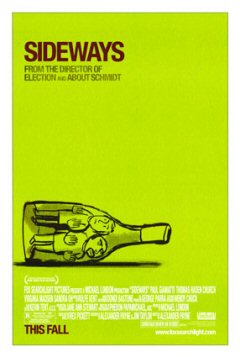

The Howling Man
As with all DVD box sets, there’s an understory to the just-out, superbly-remastered Star Wars trilogy. Or an undersaga, rather.
Star Wars is an efficently made space-myth movie that still plays pretty well and which I have no problem with. (Except for Lucas’s tinkering with Greedo shooting first. Is is true that the latest version has Greedo and Han shooting simultaneously?).
The Empire Strikes Back is, as we all know, the very best Star Wars film ever made. It’s the only big-budget fantasy flick in which the characters lose at every turn and end up worse off than when they started. Every step of the way Luke, Han Solo, and Princess Leia are ducking and running for cover and trying not to get killed. That’s all they do — they never get the upper hand. Plus it’s the best-looking (i.e., most lovingly lighted) Star Wars film ever.

Return of the Jedi was a travesty, a dud….a signaling of the corruption and the banality that was evolving in Lucas’s creative soul.
Lucas, of course, was Luke Skywalker at first — a lonely-kid dreamer who marshalled his resources and went up against the empire, succeeded hugely, and wound up creating his own kingdom. But once this power was firmly in hand, Luke started to devolve into a benign, flannel-shit-wearing Darth Vader figure — a technically-obsessed enemy of anything resembling organic creativity, a toymaker rather than a filmmaker, a digital remixer and reviser ad infinitum.
It’s the story of how a good guy grew into a kind of ogre….a demonic figure, really. A demonic figure with a mild-mannered personality, hundreds of employees who think he’s terrific, and two kids he loves and raises like any deeply devoted dad.
Remember how Albert Brooks’ character said in Broadcast News that William Hurt’s character was the devil? Meaning he was a guy who was helping to bring about degradations of standards in the TV news business and in the culture at large?

Lucas was a once-interesting filmmaker who almost singlehandedly (along with Steven Spielberg) managed to infantilize the film industry (in terms of the movies the bottom-line guys were willing to finance after the success of Jaws and Star Wars), and who also helped bring about, again with Spielberg, the first-weekend blockbuster mentality.
Lucas didn’t deliberately set out to undermine the art and wonder of film, of course, but the blockbuster mentality (a) killed the idea of gradual roll-outs, (b) brought about the idiotic high-concept movie formulas of the ’80s and ’90s, (c) maligned the idea that the making of quality movies had value in the Hollywood marketplace, and (d) helped launch the idea that to succeed big you had to dumb movies down.
Is there any one person out there who’s more responsible (on a symbolic as well as literal level) for these things than Lucas? I’d like to hear arguments.
Russ Meyer, R.I.P.
“I had dinner with Russ Meyer in Glendale back in the 1980s when I was living in Los Angeles. A friend of mine from Philly knew him, and Russ wanted to meet me since he wanted to meet everyone who’d ever mentioned him in print, and I’d mentioned him in a Siskel-Ebert Calendar story I did for the L.A. Times.
“Russ lived in a sort of Swiss chalet-like A frame somewhere in, I guess, Burbank, or in the vicinity of the Hollywood sign. Inside the house was filled from top to bottom with memorabilia, including framed stories about him, nudie pix of his wives and girlfriends, and special plaques featuring photos of certain lovers with the phrase “to the precious exchange of bodily fluids” etched into them.
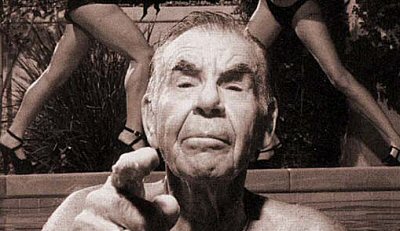
“Russ was a guy’s guy. We went to eat in one of those darkly lit man’s type restaurants that featured leather banquettes and steaks, and discussed — what else? — photography and women.
“But what I really loved about him was, first, he was a real WWII man, a combat
photographer who’d seen it all. And secondly, he may have been the only truly indie filmmaker in the business (William Goldman said this about him), considering that he had total creative and marketing control over his work. He was also a stylist of some note, and had a great sense of humor.
“My friend Irv thinks Meyer’s life would make a great movie: the war, the titty movies, the studio productions, the obscenity fight, the many lovers. I really hope someone out there in Hollywood sees the dramatic possibilities here.
“RIP, Russ — you were a true original.” — Lewis Beale
